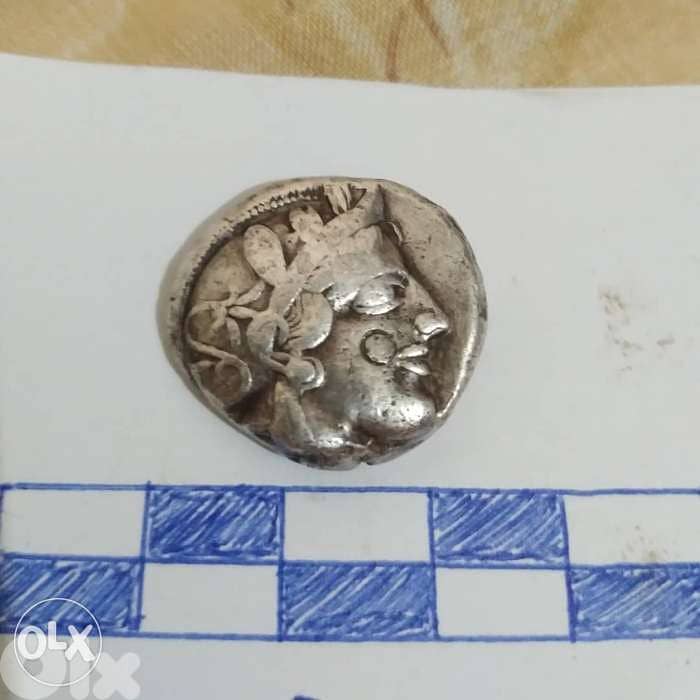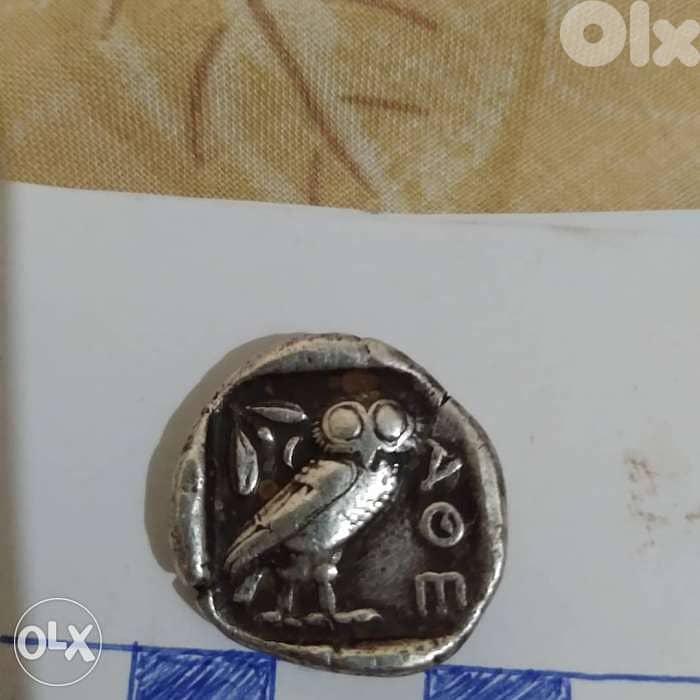1 / 2
Details
TypeCurrency
ConditionUsed
Seller TypeIndividual
Description
Greek Athena Silver Coin Tetradrachm 415 BC. Head of Athena right with frontal eye, in crested Attic helmet adorned with olive leaves above visor / A-Θ-E, owl standing three-quarters right, olive sprig behind, all in incuse square. . weight 16.7 grams
This silver coin was minted at Athens and carries a number of motifs symbolic of the city. On the obverse (principal) side is the head of Athena, patron goddess of Athens. She wears a necklace and earrings and a richly decorated helmet representing the warlike aspect of her character. The reverse of the coin shows an owl and a sprig of olive, the bird and tree associated with Athena, especially at Athens. On the right of the owl are the first three letters in Greek of the name of Athena and of Athens: AΘΗ.
The coin is a tetradrachm, meaning that it was worth four drachmas; one drachma, in turn, was worth six obols. It is a high value coin representing, in the mid-fifth century BC, four days’ pay for a skilled labourer or for a hoplite soldier, or two days’ pay for a sculptor working on a public building. It represents 12 days of welfare payment for a poor Athenian man unable to work or 24 days of pay for a citizen serving on a jury or for an unskilled labourer. This coin might have bought something like 54 litres of wheat (around 54 days’ rations for a soldier) or 12 litres of olive oil or 37 litres of local wine, but it is worth noting that estimates of prices for wheat and oil are unreliable.
The silver for the tetradrachm came from the mines at Laureion, about 50km from Athens. These were owned by the state, but contracts for digging the silver were let to private individuals. The silver from Laureion was important in the financing of Athens’ navy and of other public projects. The mines were worked by large teams of slaves working in terrible conditions in narrow passages with the only light coming from burning oil lamps. Private individuals were able to make large amounts of money from hiring out slaves to work in the mines; one Athenian politician hired out as many as 1000 slaves.
The coins were made of pure metal so they were not just a currency with symbolic value, but also bullion and thus a means of exporting the metal itself. Silver was probably the single most important Athenian export. For a period, Athens imposed her coinage on the subject cities of her empire, but the high quality of the silver in the coins meant that they circulated much more widely and have been found throughout the Mediterranean region and beyond in the Middle East and even India. Their popularity and use in trade was probably a factor in the retention of the distinctive design of Athenian coins, which was a mark of their quality. While many other cities changed coin designs quite frequently, Athens kept the same one for 200 years.
In spite of the importance of silver, most Athenians, like most other Greeks, made their living by agriculture. The wealthiest Athenian landowners held large estates; at the other end of the scale was the small farmer whose land provided him with just enough to maintain his family and to allow him to fulfil his responsibilities as a citizen. A wide variety of crops were grown and some animals were kept, but the principal three crops were cereals (mainly barley with some wheat), grapes for wine and olives. Olive oil was essential to ancient Greek life as it was the main fat consumed and was also used for lighting and for personal hygiene. Athenian olive oil was famous for its quality and was given as a prize to winners in the Athenian games, the Panathenaia – its actual as well as its symbolic importance to the city is demonstrated by the sprig of olives on the tetradrachm.
The Athenian politician Perikles remarked that Athenians, unlike other Greeks, expected to be able to enjoy products from all over the world. Very Special and Authentic Coin. To see more press on " Mohamad"
Location
Lebanon
Ad id 110960749
Report this ad
Related ads
Listed by private user
Mohamad
Member since Nov 2016
See profile
Your safety matters to us!
- Only meet in public / crowded places.
- Never go alone to meet a buyer / seller, always take someone with you.
- Check and inspect the product properly before purchasing it.
- Never pay anything in advance or transfer money before inspecting the product.




